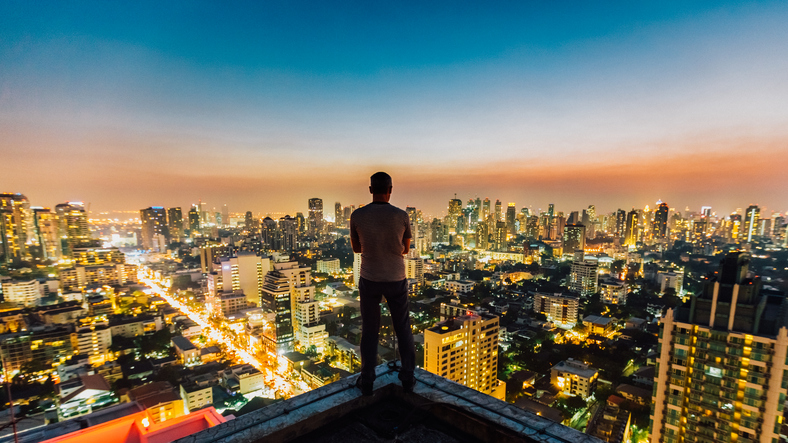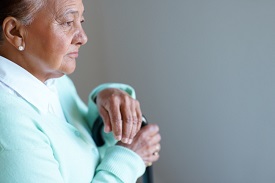 Isolation is the experience of being separated from others. It may result from being physically separated from others, such as when a person lives in a remote area. Isolation can also result from being emotionally removed from a community. (The separation could be real or perceived.)
Isolation is the experience of being separated from others. It may result from being physically separated from others, such as when a person lives in a remote area. Isolation can also result from being emotionally removed from a community. (The separation could be real or perceived.)
An isolated person may experience loneliness or low self-esteem. Over time, a person may develop social anxiety, depression, or other mental health concerns. The right therapist can help individuals build social skills and connect with others. Therapy can also help people recover from the effects of isolation.
- What Is Social Isolation?
- What Is Emotional Isolation?
- Solitude, Isolation, and Loneliness
- Age and Isolation
- Gender and Isolation
- Does Social Media Cause Isolation?
- Effects of Isolation on Physical Health
- Mental Health and Isolation
What Is Social Isolation?
Social isolation is an absence of social relationships. It is distinct from solitude, which is simply the state of being alone. Social isolation can occur in solitude or in the vicinity of others.
Solitude can be chosen or forced, healthy or unhealthy. Social isolation describes an unwanted and often harmful experience. A person may be experiencing social isolation if they:
- Avoid social interaction due to shame or depression.
- Spend extended periods of time alone.
- Experience social anxiety or fears of abandonment at the idea of social interaction.
- Have only limited or superficial social contact.
- Lack important social or professional relationships.
- Develop severe distress and loneliness.
What Is Emotional Isolation?
Emotional isolation occurs when someone is unable or unwilling to share their emotions with others. Someone may be reluctant to discuss anything but the most superficial matters. Without emotional support, they may feel “shut down” or numb.
Emotional isolation can occur due to social isolation. Yet a person may feel emotionally isolated despite having a social network. Even though relationships are necessary for our well-being, they can trigger negative feelings and thoughts. Emotional isolation can act as a defense mechanism to protect a person from distress.
Someone in an intimate relationship can still experience emotional isolation. One or both partners may feel alone within the relationship, rather than supported and fulfilled. Infidelity, abuse, and other trust issues often cause such feelings. A couples counselor can help partners identify the source of their distress. The couple can then work to improve communication and rebuild trust.
Solitude, Isolation, and Loneliness
Solitude, isolation, and loneliness are similar terms, but they have distinct meanings.
- Solitude is the state of being alone.
- Isolation is a lack of social relationships or emotional support.
- Loneliness is a craving for social contact. It is often linked to feelings of sadness and emptiness.
Spending time alone is not inherently bad. Solitude can be a healthy, rejuvenating experience. It can allow people to reconnect with their needs, goals, and feelings.
Some people require more solitude than others. Introverts, for example, enjoy spending lots of time alone and can feel drained through social interaction. Meanwhile, extroverts often need more social interaction to feel fulfilled. Circumstances that feel isolating or lonely to one person may be healthy for another.
Age and Isolation
A 2018 Cigna survey of American adults claims loneliness has reached epidemic levels across all age groups. (Although loneliness is not the same as isolation, many studies use it as a marker for isolation). According to the study:
- 43% of Americans report they often feel “isolated from others.”
- 27% feel they don’t have people who truly understand them.
- 47% do not have meaningful in-person social interactions (such as quality time with family) on a daily basis.
 Research suggests isolation is highest at both ends of the lifespan. It first peaks in adolescence and young adulthood. The survey above found Generation Z is currently the loneliest generation (represented by adults ages 18-22 years old in the study). As people make families and advance in their careers, isolation will often decline.
Research suggests isolation is highest at both ends of the lifespan. It first peaks in adolescence and young adulthood. The survey above found Generation Z is currently the loneliest generation (represented by adults ages 18-22 years old in the study). As people make families and advance in their careers, isolation will often decline.
But as people pass middle age, isolation can increase. An American Association of Retired Persons (AARP) study found 35% of Americans over the age of 45 are lonely. Lonely individuals tended to be more isolated. Lonely people were less likely to be involved in social community activities, such as attending religious services or volunteering.
Isolation often peaks a second time as people reach their senior years. Spouses and friends may die over time. Among elders, mobility and other health impairments can make it difficult to reach out to others. In 2014, 26% of people over the age of 65 lived alone.
Gender and Isolation
The role of gender in isolation is complex. Men tend to be more isolated than women. A British survey found 2.5 million (1 in 8) male Britons have no close friends, and 51% have two or fewer close friendships.
Despite this isolation, men are less likely to admit feeling lonely. A 2012 study found men were more socially isolated than women. However, women and men reported similar satisfaction with their social support network. The study authors suggest the discrepancy is due to gender socialization. The men may have been reluctant to admit they were lonely for fear of showing vulnerability.
Some research suggests toxic masculinity—restrictive norms about how men should think and feel—can play a role in male isolation. Western cultures often socialize men to be tough and stoic, even at the expense of emotional connection. Homophobia can deter men from seeking out friendships with other men. Sexism may cause them to devalue friendships with women.
Cultural and social factors can also isolate women. When women are the minority at work or school, they may feel left out. Research consistently finds that motherhood can be deeply isolating. In most families, child-rearing disproportionately falls to the woman. Recovering from childbirth can further isolate women, as can the demands of breastfeeding, the logistics of bottle-feeding, and the physical challenges of traveling with an infant or young child. This motherhood-related isolation can be a risk factor for postpartum depression. A 2013 study suggests reducing isolation and loneliness among new mothers can lower their risk of postpartum depression.
A person’s gender may be a risk factor for isolation when they don’t identify with the dominant model of gender. People who are genderfluid or nonbinary may feel isolated or lonely, especially when people around them don’t accept or understand their gender.
Does Social Media Cause Isolation?
 Social media promises to help users feel more connected. Research suggests it may have the opposite effect for younger users. A 2017 study of young adults ages 19-32 years old found frequent social media users had higher levels of perceived social isolation. The most frequent users were three times as likely to feel isolated as the least frequent users.
Social media promises to help users feel more connected. Research suggests it may have the opposite effect for younger users. A 2017 study of young adults ages 19-32 years old found frequent social media users had higher levels of perceived social isolation. The most frequent users were three times as likely to feel isolated as the least frequent users.
These results don’t mean social media use is always harmful or that all people who use social media feel isolated. For some people, social media offers access to a sense of community and belonging. This can be especially true for marginalized individuals who might have trouble connecting with people in their physical location.
Social media may be a factor in loneliness when it replaces in-person connections or when fleeting online interactions substitute for more substantive conversation. When social media is just one form of interaction, or when it increases access to meaningful relationships, it may reduce isolation.
Effects of Isolation on Physical Health
Numerous studies have documented a link between isolation, loneliness, and physical health issues. Loneliness may be as bad for a person’s health as smoking 15 cigarettes a day. Some of the many health effects of isolation and loneliness include:
- Higher levels of stress hormones and inflammation.
- Heart disease, including high blood pressure and coronary artery disease.
- A heightened risk of developing a disability.
- Increased vulnerability to chronic illnesses such as Type 2 diabetes.
Social isolation may even increase one’s risk of premature death. A 2015 study found social isolation increases a person’s risk of death by about 30%.
Mental Health and Isolation
Isolation can increase the risks of mental health issues such as depression, dementia, social anxiety, and low self-esteem. Isolation and mental health issues can also interact with one another in a feedback loop. For example, a person might develop depression because of intense loneliness, then feel even more isolated because of their depression.
Extreme isolation can have catastrophic effects on mental health. Humans are social animals who need human contact to thrive—and sometimes even to survive. Infants who don’t get enough physical contact may fail to thrive and die. Inmates held in solitary confinement, especially for extended periods of time, may experience hallucinations, insomnia, posttraumatic stress (PTSD), and difficulty telling time. More than 80,000 men, women, and children are held in solitary confinement in American prisons and jails.
If you or a loved one is experiencing isolation, you can find a therapist here. A mental health professional can also treat any mental health issues which may be contributing to the situation.
References:
- Anderson, G. (2010). Loneliness among older adults: A national survey of adults 45+. AARP. Retrieved from https://www.aarp.org/research/topics/life/info-2014/loneliness_2010.html
- Bingham, J. (2015, November 14). 2.5 million men 'have no close friends'. The Telegraph. Retrieved from https://www.telegraph.co.uk/men/active/mens-health/11996473/2.5-million-men-have-no-close-friends.html
- Brody, J. E. (2017, December 11). The surprising effects of loneliness on health. New York Times. Retrieved from https://www.nytimes.com/2017/12/11/well/mind/how-loneliness-affects-our-health.html
- By the numbers: Older adults living alone. (2016). Monitor on Psychology, 47(5), 9. Retrieved from http://www.apa.org/monitor/2016/05/numbers.aspx
- Correa, T., Hinsley, A. W., & Zúñiga, H. (2010). Who interacts on the web?: The intersection of users’ personality and social media use. Computers in Human Behavior, 26(2), 247-253. Retrieved from https://www.sciencedirect.com/science/article/pii/S0747563209001472
- De Jong Gierveld, J., van Tilburg, T., Dykstra, P. A. (2006). Loneliness and Social Isolation. In Vangelisti, A. and Perlman, D (Eds), Cambridge Handbook of Personal Relationships. (pp. 485-500). Retrieved from http://www.iscet.pt/sites/default/files/obsolidao/Artigos/Loneliness%20and%20Social%20Isolation.pdf
- Dennis, C., & Dowswell, T. (2013). Psychosocial and psychological interventions for preventing postpartum depression. Cochrane Database of Systematic Reviews. doi:10.1002/14651858.cd001134.pub3
- Greene, M. (2017, March 15). The terrible price of our epidemic of male loneliness. Retrieved from https://goodmenproject.com/featured-content/male-loneliness-megasahd/
- Harmon, K. (2010, May 06). How important is physical contact with your infant? Scientific American. Retrieved from https://www.scientificamerican.com/article/infant-touch
- Hawthorne, G., PhD. (2008). Perceived social isolation in a community sample: Its prevalence and correlates with aspects of peoples' lives. Social Psychiatry and Psychiatric Epidemiology, 43(2), 140-50. doi:http://dx.doi.org/10.1007/s00127-007-0279-8
- Holt-Lunstad, J., Smith, T. B., Baker, M., Harris, T., & Stephenson, D. (2015). Loneliness and social isolation as risk factors for mortality. Perspectives on Psychological Science, 10(2), 227-237. Retrieved from http://journals.sagepub.com/doi/abs/10.1177/1745691614568352?journalCode=ppsa
- Polack, E. (2018, May 1). New Cigna study reveals loneliness at epidemic levels in America. Retrieved from https://www.cigna.com/newsroom/news-releases/2018/new-cigna-study-reveals-loneliness-at-epidemic-levels-in-america
- Polan, H.J., Ward, M.J. (1994). Role of the mother’s touch in failure to thrive: A preliminary investigation. Journal of the American Academy of Child and Adolescent Psychiatry 33(8), 1098-1105. Retrieved from https://www.ncbi.nlm.nih.gov/pubmed/7982860
- Primack, B. A., Shensa, A., Sidani, J. E., Whaite, E. O., Lin, L. Y., Rosen, D., . . . Miller, E. (2017). Social media use and perceived social isolation among young adults in the U.S. American Journal of Preventive Medicine, 53(1), 1-8. Retrieved from https://www.sciencedirect.com/science/article/pii/S0749379717300168
- Solitary confinement facts. (2018, February 23). Retrieved from https://www.afsc.org/resource/solitary-confinement-facts
- Threat to health. (n.d.). Retrieved from https://www.campaigntoendloneliness.org/threat-to-health
- Vandervoort, D. (2012). Social isolation and gender. Current Psychology 19(3), 229-236. Retrieved from https://www.researchgate.net/publication/225540241_

